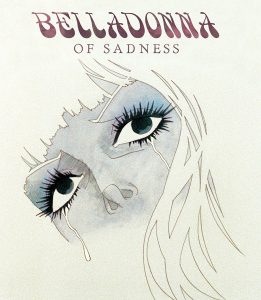
(Neo, Uncooked Media)
1973 and Mushi Production, the studio that propelled postwar anime with Astro Boy, is bankrupt, collapsing and dying. Its founder Osamu Tezuka has jumped ship. Just before the end, the studio releases a movie…
Belladonna of Sadness, directed by Tezuka’s long-time colleague Eiichi Yamamoto, is an amazing film. But it’s not quite as amazing as the fact that in 2017, we’re getting it in a plush Collector’s Blu-ray in Britain, nearly fifty years after it was released in (probably very few) Japanese cinemas. Belladonna is arty enough to make Princess Kaguya or Angel’s Egg look like Your Name. It’ll stretch many fans’ definitions of anime; some may question if it’s even animated.
There was once a time when shops would blithely put an anime title like, say, Devilman or 3×3 Eyes on the shelves beside Disney and Scooby-Doo, and in-the-know fans would have to suppress a snigger. Believe us, putting Belladonna beside, say, Naruto or Attack on Titan feels nearly as wrong.
And we’re not talking about the film’s sexual content, but about how Belladonna is told. The film opens with a twangy guitar, a lovely song… and sketchy pictures that do not move but just scroll from right to left, the natural reading direction for Japanese audiences, and for Western manga readers. Colour is added and the pictures become more refined, but it’s more than a minute before there’s any animation.
It’s important to stress this. If you watch Belladonna, you’re going to be watching lots of “still” pictures, even if those pictures are scrolled, zoomed or otherwise jerked around. Actually, a lot of the most vivid, sometimes dazzling animation is in the film’s second half, rising to match the increasingly wild story. As cash-strapped as the production was (see above), the filmmakers put their money where it mattered.
Gamer fans may look at Belladonna’s non–moving illustrations, “animated” by pictures and voice-overs, and think of Visual Novels, though the illustrations themselves feel closer to erotic French comics, bandes desinees. (Perhaps the only anime which comes close is the title sequence for The Woman Called Fujiko Mine). Older readers might think of the children’s series Jackanory… but this a Jackanory whose pictures are filled with pulsing penises and vaginas, and where one of the main characters is a laughing Satan so throbbingly priapic he makes Giger’s Aliens into shy prudes.
As a piece of erotica… Look, floating boats and all that, but we suspect many readers will find Belladonna the unsexiest film possible in which a beautiful woman spends much of the duration naked and moaning. Belladonna’s gender politics were “progressive” in 1973, which means that now it’d get banned from college film societies, or come with trigger warnings in screaming capitals.
The story is a gender-swapped reworking of the Faust legend (though its credited source is a 19th-century guide to witchcraft, La Sorcière). In medieval France, virginal Jeanne is wed to her strapping beau Jean, “blessed in the eyes of God” as the lyrics tells us. A few minutes later, she’s raped by the local lord, symbolised by her body being chainsawed, then pumped by a monstrous hypodermic. After her ordeal, Jeanne returns to Jean, the blood fresh on her legs. He talks to her gently, then nearly strangles her as damaged goods. So much for God’s blessing.
That’s when the Devil appears to Jeanne, initially as a cute flesh vibrator (he rubs himself on her palm, the cheeky fellow). Believe us, he gets much bigger. He guides Jeanne to both power and self-destruction, yet he’s more honest and loyal to her than her cruel world ever is. Jeannes’s final, seemingly nonsensical actions make at least symbolic sense if we accept what the Devil tells her repeatedly; that he is her, she is him, and they are not just the walrus but every creature on this godless earth.
That idea is illustrated through one of the film’s standout animated sequences, just after Jeanne is blasphemously born again. That process, incidentally, involved Jeanne having, or imagining, a tsunami of sex on a mountain with a mountain, illustrated by jaw-droppingly mad Yellow Submarine cartoon characters while time rewinds to the Big Bang. After sex comes death. Soon bubonic bugs zing round the screen, annihilating the world to funky music beats while screaming skeletons crumble into sand.
What today’s viewers will make of a film made by men, about a raped woman, who finds empowerment by conjuring up a giant willy… Wars have started for less! But Belladonna fits in almost perfectly to contemporary Western counterculture; to the age of The Wicker Man (another film about pagan liberation) and the animated madness of Monty Python and Fritz the Cat. The constant songs also make Belladonna feel like a concept album. If you hated the cuteness of Interstella 5555, then here’s the antidote. There’s no other film like Belladonna (literally), a doomed studio’s story of a doomed woman, now ravishing itself back to life.
[amazon_link asins=’B01JGOY2WM’ template=’ProductAd’ store=’anime04c-21′ marketplace=’UK’ link_id=’d8d46d81-a9d2-4cef-8f54-a7d1b8512e03′]
